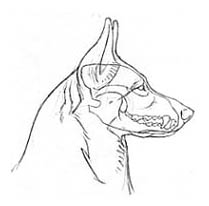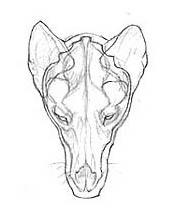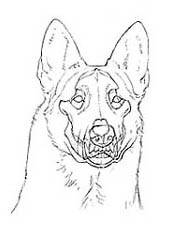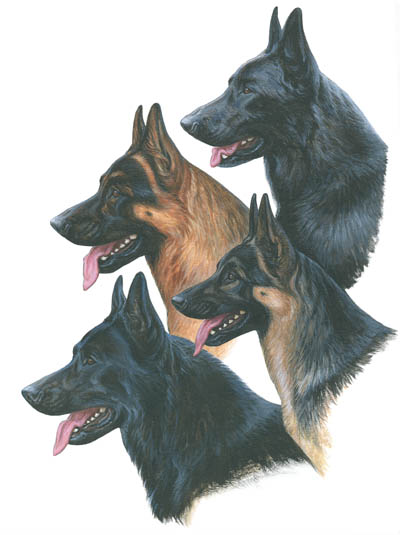The Head
Written & Illustrated by Linda
Shaw MBA
Many
might suggest that the head is of little importance, yet it
is here where the entire expression and character of the
breed resides, and where temperament and personality are
most completely revealed. Masculinity or femininity can be
determined at a glance. Health and strength can be observed
in the definition and muscling of the skull, condition of
the teeth and gums, luster of the fur and clearness of the
eyes and nose. Correct proportions give the dog strength of
grip, olfactory capacity, a roomy brain case and a beauty
and strength of expression that commands attention for a
working dog that often serves in the public eye. Without a
good head, one would be hard pressed to claim real quality
in an animal.
 A
beautiful head will exude both strength and elegance. Viewed
from the side, the skull behind the eyes is approximately
square, being as deep as it is long. It will have a defined
forehead, neither domed nor flat, but slightly arched to
give room to the brain case and added attachment area for
the jaw muscles. The back-skull lies on a plane definitely
above that of, but parallel to, the topline of the muzzle,
which is as straight as possible, neither dished nor Roman
in profile. Parallel planes give a deep, powerful upper jaw.
Interestingly, the dog which appears in life to possess a
head with parallel planes actually shows a slightly
downfaced skull, as do all wild canines, while the dog whose
skull shows parallel planes will appear, because of added
muscle and fur, to be slightly up-faced. Both can be very
beautiful and are perfectly functional.
A
beautiful head will exude both strength and elegance. Viewed
from the side, the skull behind the eyes is approximately
square, being as deep as it is long. It will have a defined
forehead, neither domed nor flat, but slightly arched to
give room to the brain case and added attachment area for
the jaw muscles. The back-skull lies on a plane definitely
above that of, but parallel to, the topline of the muzzle,
which is as straight as possible, neither dished nor Roman
in profile. Parallel planes give a deep, powerful upper jaw.
Interestingly, the dog which appears in life to possess a
head with parallel planes actually shows a slightly
downfaced skull, as do all wild canines, while the dog whose
skull shows parallel planes will appear, because of added
muscle and fur, to be slightly up-faced. Both can be very
beautiful and are perfectly functional.
While there should be
definite depth to the stop which separates back-skull from
muzzle, the transition is smooth, flowing and without
noticeable furrow. The distance between the point of the
occipital bone at the rear of the skull and the inside
corner of the eye is nearly equal to the distance between
the same point at the eye, and the tip of the nose. In
strong headed dogs, the length of the muzzle may even be
somewhat shorter than the skull, giving the jaw muscles even
greater leverage and producing an especially powerful grip.
The muzzle has the profile of a well blunted wedge, showing
a definite chin and a convex curvature of the lower line of
the jawbone, to ensure ample depth of bone to anchor deeply
rooted teeth. A square skull, moderate stop and muzzle and
jaw of correct length automatically give a deep, strong and
correctly proportioned muzzle and jaw.
 From
above, the same proportions hold. The back-skull is about as
wide as it is long, and in length is equal to or slightly
greater than the muzzle. The transition from back-skull to
muzzle is smooth, although some dogs of DDR heritage show
especially broad zygomatic arches, or cheekbones, and
massive muscling over the cheeks and skull. Again, this
produces a very powerful bite as well as an extremely strong
expression. In any event, the skull should be broad enough
to give the eyes an almost completely forward orientation,
and only enough slant to produce a beautiful, almond eyed
expression that should radiate confidence and intelligence.
Totally forward facing eyes are invariably too round, while
those situated too much to the side give a furtive, foreign
expression. Correctly set eyes are well protected by bone
without preventing a clear view of the world all round.
From
above, the same proportions hold. The back-skull is about as
wide as it is long, and in length is equal to or slightly
greater than the muzzle. The transition from back-skull to
muzzle is smooth, although some dogs of DDR heritage show
especially broad zygomatic arches, or cheekbones, and
massive muscling over the cheeks and skull. Again, this
produces a very powerful bite as well as an extremely strong
expression. In any event, the skull should be broad enough
to give the eyes an almost completely forward orientation,
and only enough slant to produce a beautiful, almond eyed
expression that should radiate confidence and intelligence.
Totally forward facing eyes are invariably too round, while
those situated too much to the side give a furtive, foreign
expression. Correctly set eyes are well protected by bone
without preventing a clear view of the world all round.
 From
the front, the head shows its square proportions yet again,
being as wide as it is deep. The muzzle too, at any point
along its length, is almost square in cross section. Breadth
of muzzle prevents crowding of the incisors, as well as
giving a wide and roomy nose with broad, open nostrils. The
top of the skull between the ears is nearly flat and the
occipital bone should be invisible from any view. A very
slight furrow at the crown is the result very strong jaw
muscles, sometimes apparent in working or DDR bred dogs. The
same strong muscling may give a large male a slightly cheeky
look. Conversely, a protruding bony ridge a the crown
indicates a lack of muscling and probably a weak grip.
From
the front, the head shows its square proportions yet again,
being as wide as it is deep. The muzzle too, at any point
along its length, is almost square in cross section. Breadth
of muzzle prevents crowding of the incisors, as well as
giving a wide and roomy nose with broad, open nostrils. The
top of the skull between the ears is nearly flat and the
occipital bone should be invisible from any view. A very
slight furrow at the crown is the result very strong jaw
muscles, sometimes apparent in working or DDR bred dogs. The
same strong muscling may give a large male a slightly cheeky
look. Conversely, a protruding bony ridge a the crown
indicates a lack of muscling and probably a weak grip.
It is from the front that the
ear set is most apparent. A beautiful set of ears is
undeniably critical to a German shepherd dog’s expression.
They should be fully erect, parallel or nearly so, medium
sized, symmetrical and open to the front. They should not
lean inwards across the skull, or flap when the dog is in
motion. While it is sometimes natural for ears to be folded
back when relaxed, this should not be the typical carriage,
as this may indicate submissiveness or weakness of
character. In my experience, dogs with strong temperament
are more inclined to let them just droop a bit when resting.
When out in public, a strong dog’s ears are always up.
Sex characteristics are most
immediately apparent in the head. A male will have a
noticeably stronger skull, with proportionately smaller
eyes, a masculine expression and a more heavily muscled and
furred neck. Loose flews and dewlap at the throat are
undesirable, but are a bit more forgivable in large, older
males. On the other hand, this does not mean the bitch has a
weaker head, merely smaller, more finely chiseled, more
feminine. There seems to be a greater acceptance of over
refinement in the bitch than in the male, which is
unfortunate as a refined female will probably have refined
brothers and sons. In a working dog, it is preferable to err
on the side of strength.

The
painting opposite illustrates three perfectly correct types
of male head, plus a good female head. The black male at the
top shows an elegant head and expression, with somewhat less
slope to the stop. The black and tan male shows a slightly
deeper stop and the bottom male exhibits the most abrupt
stop. The bottom male also shows the widest skull, and the
top male has the least wide skull. All three show correct
eye and ear set, correct dentition, strong grips and good
expression (these are actual animals). Some variability in
type is an indication of genetic variability and health, and
this is a good thing for the breed. There is no good reason
why good dogs should look like they've been stamped out of a
cookie cutter.